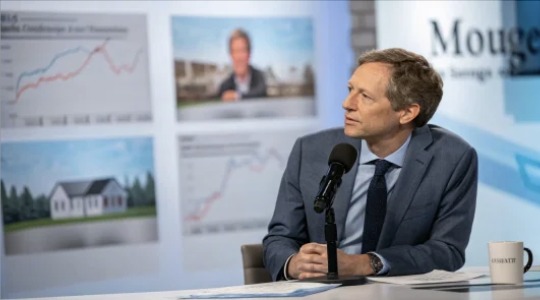Table of Contents
ToggleUnderstanding the Current Valuation
One of the key figures that caught my eye was the S&P 500 trading at 22.2 times earnings. This ratio, which measures the relative expense of market stocks compared to their earnings, serves as a historical marker that helps paint a picture of current market sentiment. Examining past instances when the S&P began at such high levels reveals that the subsequent five-year annualized returns have often been negative.
It is important to note that historical performance often serves as a reference point for future scenarios. In this particular case, the data shows that when markets are priced high relative to earnings, investors have not experienced the same kind of recoveries or gains that they might have seen when valuations were more moderate. This is a fact worth considering when making investment decisions.
View this post on Instagram
Market Headwinds and Their Impact
Several factors contribute to the possibility of lower returns when markets are priced at elevated levels. Among the most significant are trade policies, interest rate movements, and the overall health of the labor market. In a period where tariffs, trade restrictions, and geopolitical tensions gain attention, these headwinds can weigh on market performance.
In addition to these measured influences, there is also the role of unpredictable events. The market is no stranger to surprises. Historical instances such as the COVID outbreak, the collapse of major financial institutions like Lehman Brothers, and the tragic events of September 11 have all played a role in shaping market behavior. These unforeseen incidents demonstrate that risk can stem from the unknown, and the possibility always exists that future disruptions could impact performance.
I have gathered that when numerous factors align, the market’s capacity to maintain prolonged growth may be challenged. Although these headwinds impact stock performance, they also serve as a reminder of the importance of a careful strategy when managing investments.
Key Insights From Past Trends
Reflecting on previous market trends helps to put the current scenario into perspective. Data indicates that beginning an investment period when the market shows high relative pricing can lead to struggles in achieving positive returns over five years. This pattern highlights the influence of valuation levels on subsequent gains.
The key takeaway here is straightforward: investors should exercise caution when market prices are high in relation to earnings. The experience of investors in the past suggests that higher starting valuations do not always translate into long-term results that are as favorable as those seen during periods of more moderate pricing.
- High Valuation Levels: When the market is overvalued, the likelihood of achieving strong future returns diminishes.
- External Influences: Factors like trade policies and interest rate decisions contribute to market uncertainty.
- Unpredictable Events: Sudden economic shocks or global crises can abruptly alter market conditions.
These points are not meant to discourage investors; instead, they serve as a reminder of the risks inherent in any investment decision. By carefully studying market data and understanding the broader context, one can adopt a strategy that mitigates these risks.
Looking Ahead: The Future of S&P Returns
Despite the challenges presented by current high valuations, I found that a path toward positive returns over the next five years remains. Data supports that while the market might not experience the strong run witnessed in the past decade, there is still potential for growth.
What is clear from the analysis is that we should adjust our expectations. A bullish decade often comes with a series of favorable conditions that may not be present at higher valuation periods. This more tempered outlook calls for measured optimism and a focus on portfolio diversification.
Diversification remains a practical approach in an era of market fluctuation. Instead of chasing lofty gains or unrealistic expectations, investors may do well by diversifying their investments across various asset classes. Such a strategy can reduce risk and improve the opportunity for steady returns.
Learning From Past Events
The history of the market is marked by events that remind us of the inherent unpredictability of economic cycles. Events such as major financial collapses and other global disruptions have had a significant impact on returns. These episodes highlight that while data provides guidance, the market is also influenced by human behavior and unexpected crises.
The S&P 500 has never generated a positive return when starting at a point where high valuations exist.
Such statements, based on historical data, encourage us to be mindful of current pricing levels and the potential risks that may follow. It reiterates that while positive returns are possible, they may not match the extraordinary gains seen in previous periods.
The mix of known economic headwinds and unforeseen challenges adds layers of complexity to market forecasts. As an investor, it is crucial to acknowledge these factors and adjust expectations accordingly.
Practical Steps for Investors
Managing investments in this environment requires discipline and a willingness to adapt. One of the critical strategies is diversification. By spreading risk across different sectors and asset types, investors can better weather periods of lower market performance.
I recommend a cautious approach driven by data. Here are some steps worth considering:
- Review Valuations: Regularly assess market pricing and correlate it with historical performance.
- Monitor Economic Indicators: Keep an eye on interest rate trends, trade policies, and labor market conditions.
- Prepare for Uncertainty: Consider strategies that protect your portfolio from sudden market shocks.
Emphasizing these measures can help investors maintain a well-rounded portfolio, even when market conditions are less than ideal. While the data suggests a more modest performance period ahead, a strategic outlook can still lead to steady growth.
Balancing Data With Market Sentiment
There is always a tension between data-driven insights and the naturally optimistic narratives that sometimes circulate among investors. At times, the market is swayed by speculative optimism, which can lead to bubbles or unsustainable growth. In contrast, a grounded analysis based on historical data offers a more nuanced forecast.
Among the lessons learned, it is essential to trust the numbers. The data indicates that high market valuations have a history of leading to lower five-year returns. This serves as a reminder to strike a balance between hope and reality.
It is not about instilling fear but fostering a more prudent approach. Investors who choose to focus on sound principles rather than chasing unrealistic expectations often fare better in the long run.
Reflections on the Broader Economic Outlook
Economic headwinds such as trade policies and interest rate movements set the stage for the market’s future. The data underscores that when these factors combine with high valuations, the opportunity for robust returns may diminish. While much has been made of past successes, it is clear that the future may hold a period of steadier but less spectacular growth.
The analysis is based on clear patterns from previous market cycles. When prices are high relative to earnings, investors have historically faced a more challenging road ahead. This insight is crucial for anyone seeking to navigate the current economic conditions with a rational perspective.
By aligning our strategies with historical data and remaining alert to economic signals, it is possible to both mitigate risk and position oneself for gradual gains over time.
Final Thoughts and Recommendations
After a careful review of market data and historical performance, the outlook for the S&P 500 suggests that investors should approach the next five years with a balanced view. Although the historical record suggests challenges when starting from high valuation points, there is still room for positive returns if one remains patient and strategic.
My journey through the numbers has reinforced the vital importance of a diversified approach. By not putting all eggs in one basket and basing decisions on solid data rather than promises of extraordinary returns, investors can better safeguard their portfolios.
Ultimately, the prudent course of action is to acknowledge that while future returns might not replicate the extraordinary gains of the past decade, they can still be positive over time. Data and history offer valuable lessons for navigating these times. My advice is to remain informed, adjust expectations, and maintain a diversified investment strategy.

















